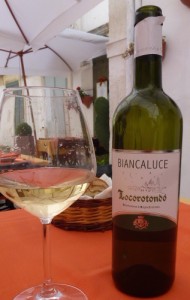
Biancaluce wine. PHOTO: Terry Duarte
Last spring when my wife and I visited the Italian region of Puglia (on the southern Adriatic Coast below the region of Molise down to the boot and around past the city of Taranto), we discovered quite by accident a really good dry white wine. At an outdoor trattoria in the beautiful seaside resort city of Vieste the chef suggested we try a local white wine with our seafood dinner. The wine he recommended was called Locorotondo, produced in a nearby town of the same name. The meal was excellent and the wine equally enjoyable. Unfortunately, the restaurant served it as a house wine and we did not think to ask for the name of the producer.
A few days later, we visited the quaint town of Locorotondo with its whitewashed buildings and narrow streets and alleys. When we sat down to eat lunch at another small outdoor trattoria, we asked for a bottle of Locorotondo to accompany the meal. Our server, the daughter of the owner and chef, brought us a bottle of Biancaluce, the lower priced Locorotondo produced by the Cantina Sociale Cooperativa in the town of Locorotondo. Like the previous Locorotondo we had tried in Vieste, this wine proved to be excellent.
Recently a friend in the PR business, Ann Willets, sent me a wine to taste. I normally don’t like wines with cute names and I prefer Pinot Grigio produced in higher altitudes like the Dolomite foothills. However, this wine, Chill Pinot Grigio, a “Della Venezia” offering, was really nice and sells for less than $10 per bottle. I recommend it as an inexpensive but good purchase.
The Cantina Sociale Cooperativa of Locorotondo consists of 1,300 producers in the local area whose combined annual production is 5.5 million bottles. There are two white Locorotondos and a large variety of reds, rosés and sparkling wines. Wine production has existed in this area since 1195 AD. I can’t comment on any of the other wines offered by the Cantina, but I can speak on the Biancaluce.
The Baincaluce is produced from vines that vary in age from 10-25 years in age. The composition is 65% Verdeca, 30% Bianco d’Alessano and 5% Fiano. The grapes are soft pressed and some natural yeast is added and alcoholic fermentation is conducted at 20°C for 15-20 days. Sediment is extracted through decantation and the wine is stored in stainless steel tanks under an inert gas blanket. After approximately three months, the wine is stabilized, filtered and bottled cold.
The finished result is a pale yellow/green wine with a slight fruit nose and a dry medium but smooth and pleasing finish. I rate this wine an 89. For the price, it is a bargain. If you see it on a menu, give it a try.




